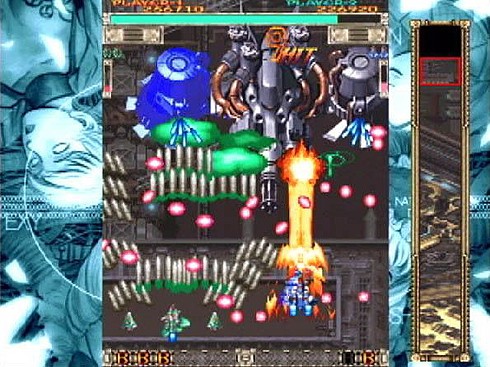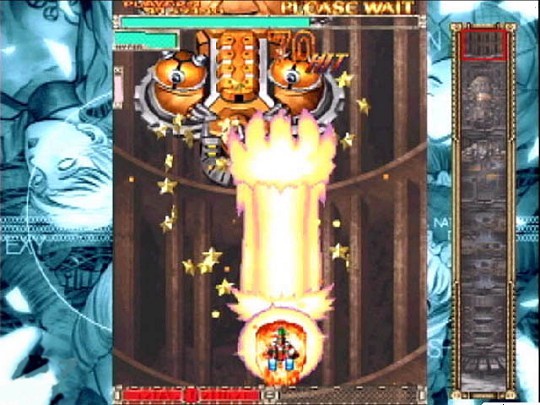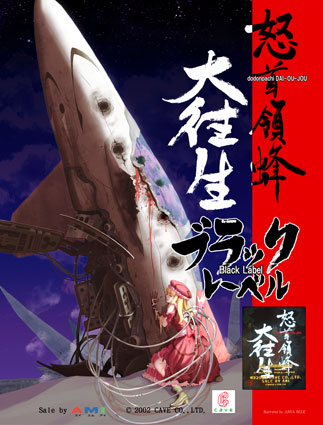Last updated on March 4, 2013
I’m sure every gamer has been privy to the golden age of video gaming at some point, if not by experience than at least by the various compilations of old games that continue to pile up. This was a time when arcades were popular, Gradius and R-Type innovated the shooter genre and brought leagues of players towards their flickering arcade cabinets, waiting for a chance to waste their money. These were games that offered huge challenges – everything wants to kill you. It was the one man show; one ship against many, you as the savior of the universe.
Alas, the shoot ‘em up has descended into darker days, mostly from the advent of the 3D graphics engine we know and love today. To be honest, it’s just difficult to realign an entire genre from a flat 2D plane to a full 3D world. Some game types made a successful transition (The platformer, with Super Mario 64, being a good example). Shmups, as they are often called, have tried, but not always with great success. 2D is still where they excel, and this is where the Japanese company called CAVE has thrived for the past decade (at least in game design, if not finances).
CAVE started the manic shmup genre with DonPachi, their first game. This new trend in shooters involved massive quantities of pretty and colorful bullets being thrown at the player, who at first glance couldn’t possibly make it through the game. Yet, the saving grace appeared to be the ship’s deceptively small hit box – only a small section of the ship actually registered a hit, which meant destruction. Players began to slip through holes in the waves of flowery death with practice, bringing a rush and a thrill to the hardcore willing to go through the trouble of learning the game. That was 1995. 7 years later, with one sequel, Cave decided to create the hardest shmup in existence (already eclipsed, I’m sure). DoDonPachi: Dai-Ou-Jou (Or Double Bee Storm: Peaceful Death) is that game. This tough as nails shooter tests your skills, your brain, and your reflexes for every second you are playing.

DOJ (shortened for my sanity) is a vertical shmup, and while the concept isn’t new, the complexities certainly are. Press the shoot button, you shoot. Hold the shoot button, you shoot a huge laser (and I mean HUGE). Press the bomb button, and a bomb comes out and blasts everything on screen. Shoot a bomb with the laser out, and the laser beam gets enchanced. You can pick up power ups for the laser and shot through destroying cargo ships, and these can be upgraded about 5 times or so for a more devastating and wider-ranged weapon.
Here’s where we get crazy. At the beginning of the game, one gets to choose one of 2 ships, A or B. A has more maneuverability while B has greater firepower. In addition, you must choose a pilot, each with its own characteristics. Shotia, for example, has a very powerful regular shot, but her laser slows down the ship a great deal. However, she gets 6 bombs. Exy, on the other hand, gets 2 bombs, but moves at normal speed with either shot. One picks up upgrades through the game for the shot as well. When you die, your ship loses a certain amount of powerups – Shotia loses 3 levels or so, while Exy loses only one. Certainly, it’s alot to think about just starting what appears to be a simple shmup, but trust me; each ship/pilot combo has different intracacies. You’ll play a while just to find out what you like best for strategies on getting through the levels (I’m an A/Exy player myself).
The levels themselves are excellently designed. Enemies pop out from all angles, shooting bullets eagerly hoping for your demise, but not unfairly. Enough play reveals that enemies exist in certain patterns and shoot wherever you are at the moment they fire. Thus, it’s determining the best path and position for your ship that is the main challenge. There’s a reason why they call these games “bullet hell” shooters, and that descriptor fits DOJ quite perfectly. At all times (Especially starting with Level 3), enemies and bullets stream out at incomprehensible rates at first glance. How do you win at this, then? Spamming bombs? (They remove enemy fire from the screen, by the way). No, of course not!
What is absolutely fascinating is that it can be completed without dying. ONCE. In fact, CAVE has designed the game utilizing a “single credit” rule, and it’s designed to be played as such. That’s a bold decision in today’s gaming world; even in 2002, the console market continued to make games easier and easier, while arcade (Japanese ones) games raised their barrier of entry in response. If you meet certain requirements, the game can also be played over again in the dreaded “Second Loop”, which ups the difficulty a few notches past insane. More bullets, tougher enemies, and a super secret final boss (as well as a lack of continues) makes this content something mere mortals will never see. Cave has to be applauded for the design allowing a one credit play through. The first loop, at least, is something people can achieve.
At the same time that you strive to survive, you must also worry about your score. This might be a foreign concept if you’ve never played an arcade game, but this is where a shmup player’s skill is determined. The scoring system in DOJ is deceptively simple. Basically, killing enemies constantly garners you a chain (Denoted by the “HITS” word appearing). There are a couple prerequisites for keeping this chain going: 1. Something must be hit by your bullets before your score meter (in the upper right hand corner of the screen) expires or 2. Your laser must be kept on a target (which will stop the degeneration of said meter).
Now, this might seem easy, but destroying enemies too fast can destroy your chain. Too slow, and the chain also ends. Playing through the levels repeatedly and understanding their layout is the only way to get the practice to suceed. The PS2 version, luckily, give you a simulation mode to choose what stage and particular circumstances (ship, powerups, etc) you want to test and experiment if that ONE part gives you trouble.

There is one more element, however, that adds to the difficulty as well as the score: Hypers. They are your best friend for scoring high, but not so much for your survival chances. Simply put, if you can get a chain going long enough, a nice purple item will appear, and the word “Hyper” appear where your bombs would be (It might also be a good time to note that pressing the bomb button now will unleash the hyper, which you might not want to happen immediately). The hyper makes your shots glow bright yellow, make them more powerful, and cover a wider radius than even the highest normal upgrades. Hypers chain like crazy, bringing your score incredibly high if used correctly. However, they do something bad when activated: they increase the speed of ALL bullets. This effect (called a rank up) persists until you lose your ship, and most likely you don’t want that to happen. One must skirt the edge of getting a higher score or surviving until the next stage – lost all your lives, and your score is set in stone; continue, and it’s eliminated. Thus, judicious use of hypers is up to the player, and it’s his strategizing that makes the game even more fun. As you can see, the scoring is rather intricate, as well as integral to the gameplay (Points = extra lives!).
The graphics are quite nice. Sticking to the 2D style, Cave has become known for carefully crafted, highly detailed visuals. Everything animates beautifully, and the battlefield isn’t cluttered: those bullets are bright blue and pink to make sure you can pass through them. However, the music really takes the cake. Best described as an eclectic mix of electronica and haunting melodies, it really gets you into the zone for the game and the coming tribulations. You’ll be bobbing your head and humming the tunes long after you play (and as you replay the levels in your head; trust me, you’ll be strategizing alot once you get the core mechanics down). For the PS2, there’s 2 soundtrack choices as well, the arcade original and the arrange (both of which are fantastic). The sound is what it is; it does it job, and does it admirably. Whatever space ships shooting at each other would sound like, this would be it.
I won’t lie: this game is hard. Hard to the point of frustration, arcade joystick throwing madness unless you know what you’re getting into from the very start. Best point of advice:
1. Do not play this game to relax; it’s meant to give you a heart attack, not snooze.
2. Don’t play this game when you’re tired; you want to be fully alert to avoid being discouraged.
I’ve done 1 and 2, and believe me, those are the worst times to play. Be active or drink some coffee before playing the game. Acute spacial awareness is neccesary to bob and weave through the madness.
In addition, for those that define replay value as 25 levels or something else…you’re not gonna find unlockables here. This is pure action, and the only reward is your successful run through something you though impossible days beforehand. It’s quite amazing what you can accomplish with practice. DOJ encourages you to dive into the moving wall of death and come out unscathed. Some may be turned off by this, but that’s their loss. The learning curve, as you might expect, is also fierce, but that comes with time as well. Unlimited continues are here, but the true hardcore try with one credit and stop. Lots of practice is required as well; sometimes your path through the level (your plan) might not work as intended. However, the practice is time well spent.
Anything worth doing in life requires determination, practices, and implementation. That which you believe should be reflected in one’s life. 1 John 3 has more to say:
See how great a love the Father has bestowed on us, that we would be called children of God; and such we are. For this reason the world does not know us, because it did not know Him. 2 Beloved, now we are children of God, and it has not appeared as yet what we will be. We know that when He appears, we will be like Him, because we will see Him just as He is. 3 And everyone who has this hope fixed on Him purifies himself, just as He is pure.
4 Everyone who practices sin also practices lawlessness; and sin is lawlessness. 5 You know that He appeared in order to take away sins; and in Him there is no sin. 6 No one who abides in Him sins; no one who sins has seen Him orknows Him. 7 Little children, make sure no one deceives you; the one who practices righteousness is righteous, just as He is righteous; 8 the one who practices sin is of the devil; for the devil has sinned from the beginning. The Son of God appeared for this purpose, to destroy the works of the devil. 9 No one who is born of God practices sin, because His seed abides in him; and he cannot sin, because he is born of God. 10 By this the children of God and the children of the devil are obvious: anyone who does not practice righteousness is not of God, nor the one who does not love his brother.
You act as you are, in times both entertaining and serious. I work as hard as I play; the dividing line between the two has increasingly blurred. I want to do my best, simply because I understand my status as a child of God is a gift. To practice sin is to deny that position and ignore it, almost as an afterthought. One must practice what they preach, or ignoring the preaching and focus on the practice. What was difficult at first becomes second nature.
As Aristotle might say,”We are not studying in order to know what virtue is, but to become good, for otherwise there would be no profit in it.” If Thomas Aquinas contributed anything to Western culture, it’s the notion of the Good as excellent in and of itself. But the Good doesn’t need to be described; it needs to be practiced. In practice does it become clear what its true meaning is.
CAVE shooters, then, give little tangible rewards. They represent a mountain to be climbed, and the journey (to be entirely cliched) becomes the destination. The experience of playing it and achieving mastery is good in itself. The skills you learn can actually be applied to a variety of games. That’s quite a reward. It is this that makes DOJ an exceptional game that demands your best; if you do not give it, it will crush you. But if you raise yourself to its standards, the joy of conquest over the games transcends the usual pittances of “rewards” in games.
So it is in games, so it is in life.

